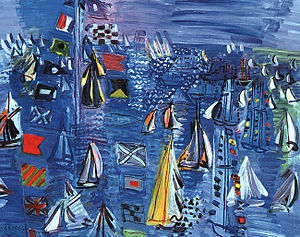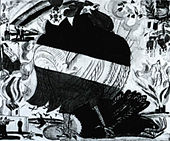- Raoul Dufy
-
Raoul Dufy Born 3 June 1877
Le Havre, FranceDied 23 March 1953 (aged 75)
Forcalquier, FranceNationality French Field Painting, drawing, design, printmaking Training École nationale supérieure des Beaux-Arts Movement Fauvism, impressionism, modernism, cubism Works La Fée Electricité (1937) Influenced by Claude Monet, Camille Pissarro, Henri Matisse, Paul Cézanne Raoul Dufy[p] (3 June 1877 – 23 March 1953) was a French Fauvist painter. He developed a colorful, decorative style that became fashionable for designs of ceramics and textiles, as well as decorative schemes for public buildings. He is noted for scenes of open-air social events. He was also a draftsman, printmaker, book illustrator, a theatrical set-dresser, a designer of furniture, and a planner of public spaces.
Contents
Biography
Raoul Dufy was born into a large family at Le Havre, in Normandy. He left school at the age of fourteen to work in a coffee-importing company. In 1895, when he was 18, he started taking evening classes in art at Le Havre's École d'Art (municipal art school). The classes were taught by Charles Lhuillier, who had been, forty years earlier, a student of the remarkable French portrait-painter, Ingres. There, Dufy met Raymond Lecourt and Othon Friesz with whom he later shared a studio in Montmartre and to whom he remained a lifelong friend. During this period, Dufy painted mostly Norman landscapes in watercolors.
In 1900, after a year of military service, Dufy won a scholarship to the Ecole Nationale Superieure des Beaux-Arts in Paris, where again he crossed paths with Othon Friesz. (He was there when Georges Braque also was studying.) He concentrated on improving his drawing skills. The impressionist landscape painters, such as Claude Monet and Camille Pissarro, influenced Dufy profoundly. His first exhibition (at the Exhibition of French Artists) took place in 1901. Introduced to Berthe Weill in 1902, Dufy showed his work in her gallery. Then he exhibited again in 1903 at the Salon des Independants. A boost to his confidence: the painter, Maurice Denis, bought one of his paintings. Dufy continued to paint, often in the vicinity of Le Havre, and, in particular, on the beach at Sainte-Adresse, made famous by Eugene Boudin and Claude Monet. In 1904, with his friend, Albert Marquet, he worked in Fecamp on the English Channel (La Manche).
Henri Matisse's Luxe, Calme et Volupté, which Dufy saw at the Salon des Indépendants in 1905, was a revelation to the young artist, and it directed his interests towards Fauvism. Les Fauves (the wild beasts) emphasized bright color and bold contours in their work. Dufy’s painting reflected this aesthetic until about 1909, when contact with the work of Paul Cézanne led him to adopt a somewhat subtler technique. It was not until 1920, however, after he had flirted briefly with yet another style, cubism, that Dufy developed his own distinctive approach. It involved skeletal structures, arranged with foreshortened perspective, and the use of thin washes of color applied quickly, in a manner that came to be known as stenographic.
Dufy's cheerful oils and watercolors depict events of the time period, including yachting scenes, sparkling views of the French Riviera, chic parties, and musical events. The optimistic, fashionably decorative, and illustrative nature of much of his work has meant that his output has been less highly-valued critically than the works of artists who have addressed a wider range of social concerns.
Dufy completed one of the largest paintings ever contemplated, a huge and immensely popular ode to electricity, the fresco La Fée Electricité for the 1937 Exposition Internationale in Paris.
Dufy also acquired a reputation as an illustrator and as a commercial artist. He changed the face of local fashion and fabric design with his work for Paul Poiret. He painted murals for public buildings; he also produced a huge number of tapestries and ceramic designs. His plates appear in books by Guillaume Apollinaire, Stéphane Mallarmé, and André Gide.
In the late 1940s and early 1950s Dufy exhibited at the annual Salon des Tuileries in Paris. Dufy died at Forcalquier, France, on 23 March 1953, and he was buried near Matisse in the Cimiez Monastery Cemetery in Cimiez, a suburb of the city of Nice.
Work outside of painting
In 1909, Raoul Dufy was commissioned by Paul Poiret to design stationery for the house, and after 1912[1] designed textile patterns for Bianchini-Ferier used in Poiret's[2] and Charvet's[3] garments.
Works
- Hommage à Mozart, (Web Gallery Private Art Collection)
- Le 14 juillet au Havre, rue pavoisée, (1906, Web Gallery Private Art Collection)
- French modern art exhibition 1939 treasure 3 National Library of Latvia displayed via The European Library
- Works by Raoul Dufy (public domain in Canada)
Notes
- [p] - The name Raoul Dufy is pronounced as "Rah-ool Dew-fee".[4]
- ^ Tourlonias, Anne (1998) (in French). Raoul Dufy, l'œuvre en soie. Avignon: Barthelemy. p. 41. ISBN 2879230942. "Le 1er mar 1912, Raoul Dufy et Charles Bianchini signent le contrat."
- ^ Hay, Susan (1999). From Paris to Providence, Fashion, Art and the Tirocchi Dressmakers' Shop, 1915-1947 ("Modernism in Fabric: Art and the Tirocchi Textiles"). Rhode Island School of Design. http://tirocchi.stg.brown.edu/essays/print/hay_fabric.html.
- ^ Raoul Dufy: Paintings, Drawings, Illustrated Books, Mural Decorations, Aubusson Tapestries, Fabric Designs and Fabrics for Bianchini-Férier, Paul Poiret Dresses, Ceramics, Posters, Theatre Designs. London: Arts Council of Great Britain. 1983. p. 106.
- ^ "C.U.S.D. Art Masterpiece Manual", Mary Lynne Lasure, p.37, web: CUSD-artm-PDF.
Fauvism Leaders Others Alice Bailly · Georges Braque · Charles Camoin · Kees van Dongen · Raoul Dufy · Henri Evenepoel · Othon Friesz · Henri Manguin · Albert Marquet · Jean Puy · Georges Rouault · Maurice de Vlaminck
Paintings Luxe, Calme et Volupté · Le bonheur de vivre · The Open Window · Landscape at Collioure · Les toits de Collioure · Blue Nude (Souvenir de Biskra) · Green Stripe · Woman with a Hat
Influences Paul Cézanne · Paul Gauguin · Vincent van Gogh · Gustave Moreau (teacher) · Georges Seurat · Paul Signac · Neo-impressionism · Pointillism
Influenced See also Louis Vauxcelles (critic) - Related navpages:
- {{Post-Impressionism}} {{Avant-garde}}
- {{Western art movements}}
Categories:- 1877 births
- 1953 deaths
- Cubism
- Fauvism
- French painters
- Impressionist painters
- Modern painters
- People from Le Havre
- School of Paris
Wikimedia Foundation. 2010.


